Thoth
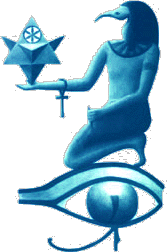
God of the Moon, Magic and Writing
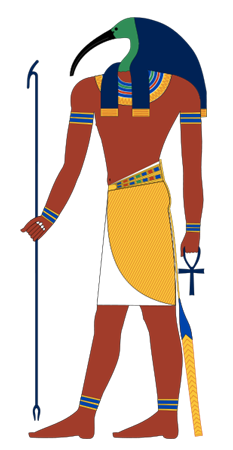
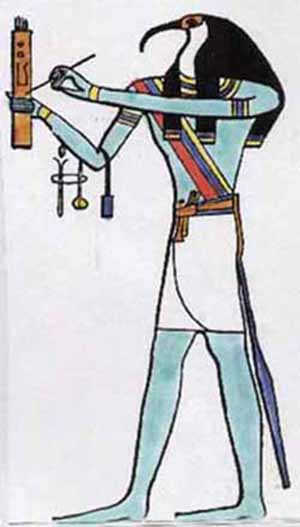
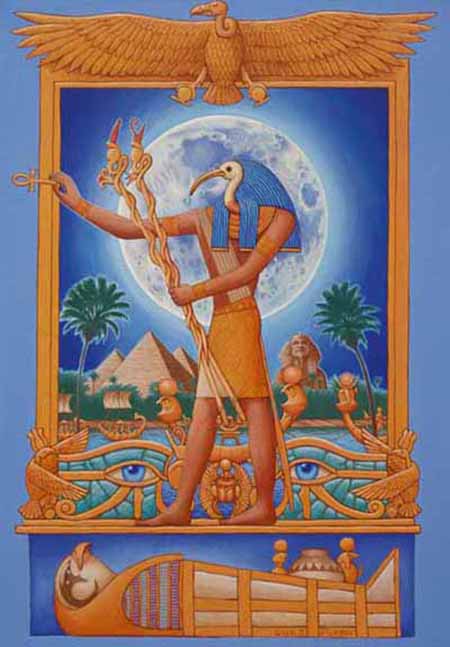
The Key of Life
Thoth's other names include Djehuty, Jehuti, Tahuti, Tehuti, Zehuti, Techu, or Tetu, Lord of the Khemenu. One of Thoth's titles, "Three times great, great" was translated to the Greek (Trismegistos) making Hermes Trismegistus.
Thoth was considered one of the more important deities of the Egyptian pantheon, often depicted with the head of an Ibis. His feminine counterpart was Seshat. His chief shrine was at Khemennu, where he led the local pantheon, later renamed Hermopolis by the Greeks (in reference to him through the Greeks' interpretation that he was the same as Hermes) and Eshmunen in Coptic. He also had shrines in Abydos, Hesert, Urit, Per-Ab, Rekhui, Ta-ur, Sep, Hat, Pselket, Talmsis, Antcha-Mutet, Bah, Amen-heri-ab, and Ta-kens.
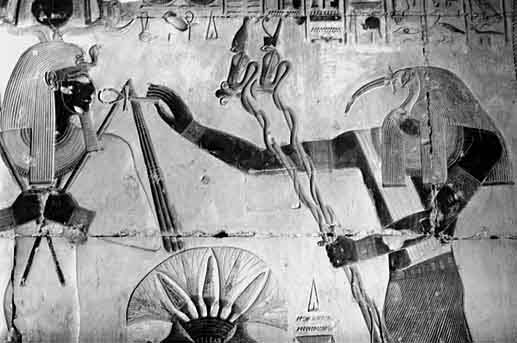
Thoth and Seti at Abydos
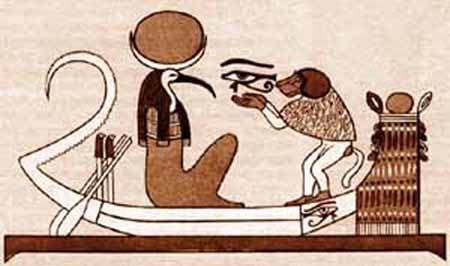
Thoth and the Eye of Ra
He was considered the heart and tongue of Ra as well as the means by which Ra's will was translated into speech. He has also been likened to the Logos of Plato and the mind of God (The All).
Thoth, like many Egyptian gods and nobility, held many titles. Among these were "Scribe of Ma'at in the Company of the Gods," "Lord of Ma'at," "Lord of Divine Words," "Judge of the Two Combatant Gods," "Judge of the Rekhekhui, the pacifier of the Gods, who Dwelleth in Unnu, the Great God in the Temple of Abtiti," "Twice Great," "Thrice Great,"" and "Three Times Great, Great."
Thoth has been involved in arbitration, magic, writing, science and the judging of the dead.
In the Egyptian mythology, he has played many vital and prominent roles, including being one of the two deities (the other being Ma'at) who stood on either side of Ra's boat. In the underworld, Duat, he appeared as an ape, A'an, the god of equilibrium, who reported when the scales weighing the deceased's heart against the feather, representing the principle of Ma'at, was exactly even.
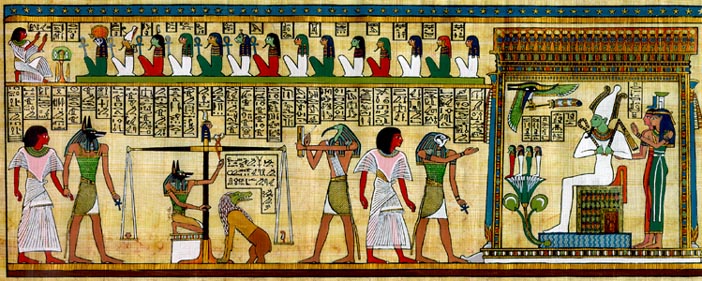 Depictions of Thoth
Depictions of ThothIn art, Thoth has been depicted in many ways depending on the era and on the aspect the artist wished to convey. Thoth was usually depicted with the head of an ibis, deriving from his name, and the curve of the ibis' beak, which resembles the crescent moon. Sometimes, he was depicted as a baboon holding up a crescent moon, as the baboon was seen as a nocturnal, and intelligent, creature. The association with baboons led to him occasionally being said to have as a consort Astennu, one of the (male) baboons at the place of judgment in the underworld, and on other occasions, Astennu was said to be Thoth himself.

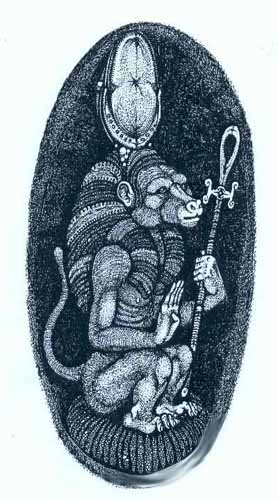
He also appears as a dog faced baboon or a man with the head of a baboon when he is A'an, the god of equilibrium. In the form of A'ah-Djehuty he took a more human-looking form. These forms are all symbolic and are metaphors for Thoth's attributes. The Egyptians did not believe these gods actually looked like humans with animal heads . For example, Ma'at is often depicted with an ostrich feather, "the feather of truth," on her head , or with a feather for a head.
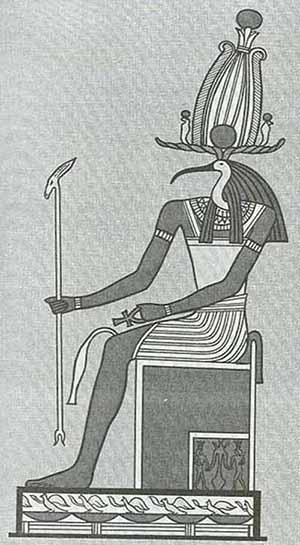
Thoth on his throne
Cairo Museum: Thoth, Sobek and Wadjet ... remind one of penguins.
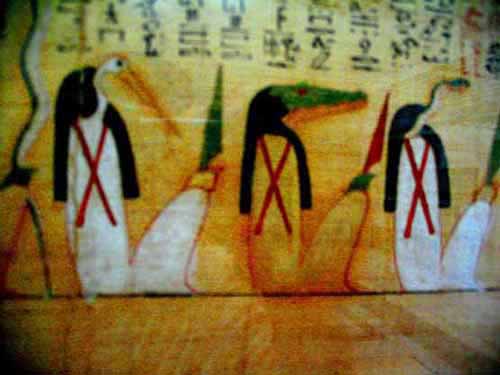
Letter X = Above and BelowThoth and Seshat
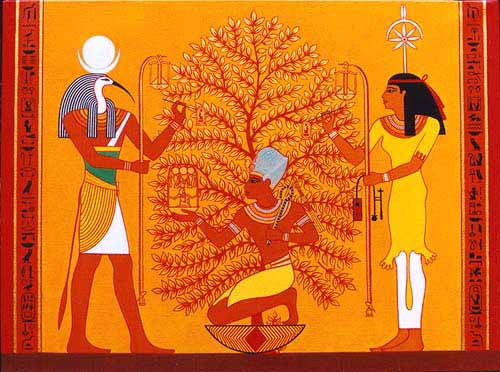 The Tree of Life
The Tree of Life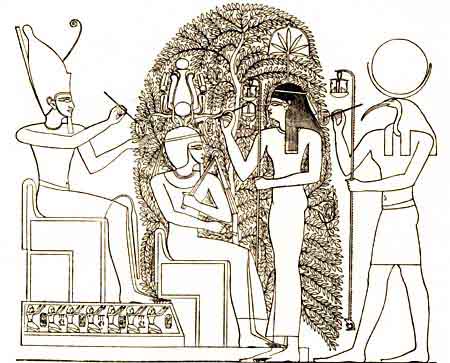 Thoth was thought to be scribe to the gods, who kept a great library of scrolls, over which one of his wives, Seshat (the goddess of writing) was thought to be mistress. He was associated by the Egyptians with speech, literature, arts, learning. He, too, was a measurer and recorder of time, as was Seshat. Many ancient Egyptians believed that Seshat invented writing, while Thoth taught writing to mankind. She was known as 'Mistress of the House of Books', indicating that she also took care of Thoth's library of spells and scrolls.
Thoth was thought to be scribe to the gods, who kept a great library of scrolls, over which one of his wives, Seshat (the goddess of writing) was thought to be mistress. He was associated by the Egyptians with speech, literature, arts, learning. He, too, was a measurer and recorder of time, as was Seshat. Many ancient Egyptians believed that Seshat invented writing, while Thoth taught writing to mankind. She was known as 'Mistress of the House of Books', indicating that she also took care of Thoth's library of spells and scrolls.Seshat is the Goddess of Libraries
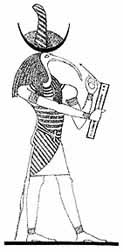
 all forms Writing
all forms Writing 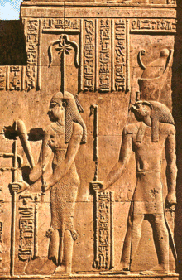 and the Measurement of Time.
and the Measurement of Time.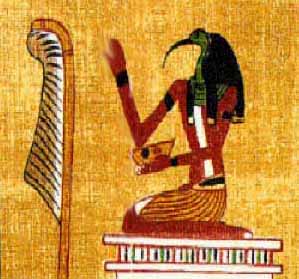 Thoth The Scribe
Thoth The Scribe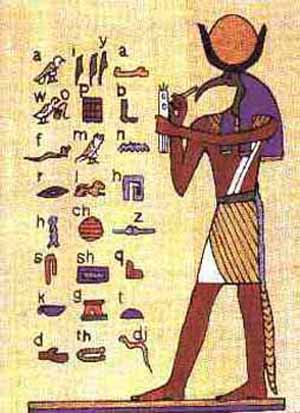
Thoth became credited by the ancient Egyptians as the inventor of writing, and alphabets (ie. hieroglyphs) themselves. He was also considered to have been the scribe of the underworld, and the moon became occasionally considered a separate entity, now that Thoth had less association with it, and more with wisdom. For this reason Thoth was universally worshiped by ancient Egyptian Scribes.
Thoth the Scribe, wrote the story of our reality then placed it into grids for us to experience and learn through the alchemy of time and consciousness.
Thoth became credited as the inventor of the 365-day (rather than 360-day) calendar, it being said that he had won the extra 5 days by gambling with the moon, then known as Iabet, in a game of dice, for 1/72nd of its light (5 = 360/72). When the Ennead and Ogdoad systems started to merge, one result was that, for a time, Horus was considered a sibling of Isis, Osiris, Set, and Nephthys, and so it was said that Hathor/Nuit had been cursed against having children during the (360) day year, but was able to have these five over the 5 extra days won by Thoth.Attributes
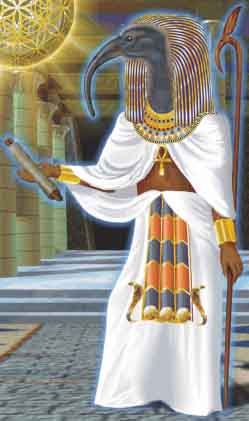
Thoth was a master magician
The Egyptians credited him as the author of all works of science, religion, philosophy, and magic. The Greeks further declared him the inventor of astronomy, astrology, the science of numbers, mathematics, geometry, land surveying, medicine, botany, theology, civilized government, the alphabet, reading, writing, and oratory. They further claimed he was the true author of every work of every branch of knowledge, human and divine.
Egyptologists disagree on Thoth's nature depending upon their view of the Egyptian pantheon. Most Egyptologists today side with Sir Flinders Petrie that Egyptian religion was strictly polytheistic, in which Thoth would be a separate god.
His contemporary adversary, E. A. Wallis Budge, however, thought Egyptian religion to be primarily monotheistic where all the gods and goddesses were aspects of the God Ra, similar to the Trinity in Christianity and devas in Hinduism. In this view, Thoth would be the aspect of Ra which the Egyptian mind would relate to the heart and tongue.
His roles in Egyptian mythology were many. Thoth served as a mediating power, especially between good and evil, making sure neither had a decisive victory over the other.
The ancient Egyptians regarded Thoth as One, self-begotten, and self-produced. He was the master of both physical and moral (ie. Divine) law, making proper use of Ma'at. He is credited with making the calculations for the establishment of the heavens, stars, Earth, and everything in them. Compare this to how his feminine counterpart, Ma'at was the force which maintained the Universe. He is said to direct the motions of the heavenly bodies. Without his words, the Egyptians believed, the gods would not exist. His power was almost unlimited in the Underworld and rivaled that of Ra and Osiris.
Mythology
Thoth has played a prominent role in many of the Egyptian myths. Displaying his role as arbitrator, he had overseen the three epic battles between good and evil. All three battles are fundamentally the same and belong to different periods. The first battle took place between Ra and Apep, the second between Heru-Bekhutet and Set, and the third between Horus, the son of Osiris, and Set. In each instance, the former god represented order while the latter represented chaos. If one god was seriously injured, Thoth would heal them to prevent either from overtaking the other.
Thoth was also prominent in the Osiris myth, being of great aid to Isis. After Isis gathered together the pieces of Osiris' dismembered body, he gave her the words to resurrect him so she could be impregnated and bring forth Horus. When Horus was slain, Thoth gave the formula to resurrect him as well. Similar to God speaking the words to create the heavens and Earth in Judeo-Christian mythology, Thoth, being the god who always speaks the words that fulfill the wishes of Ra, spoke the words that created the heavens and Earth in Egyptian mythology.
This mythology also credits him with the creation of the 365 day calendar. Originally, according to the myth, the year was only 360 days long and Nut was sterile during these days, unable to bear children. Thoth gambled with Khonsu, the moon, for 1/72nd of its light (360/72 = 5), or 5 days, and won. During these 5 days, Nut gave birth to Kheru-ur (Horus the Elder, Face of Heaven), Osiris, Set, Isis, and Nepthys.
In the Ogdoad cosmogony, Thoth gave birth to Ra, Atum, Nefertum, and Khepri by laying an egg while in the form of an ibis, or later as a goose laying a golden egg.
Thoth in the Book of the Dead
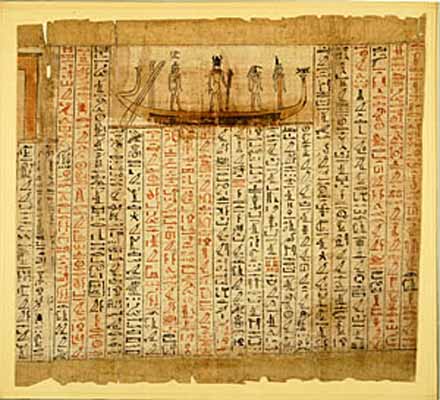 Thoth also went by the name of Tehuti,
Thoth also went by the name of Tehuti, 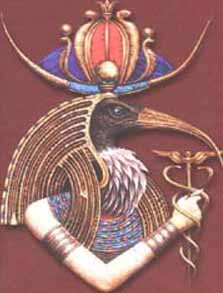
the ruler of AtlantisHistory
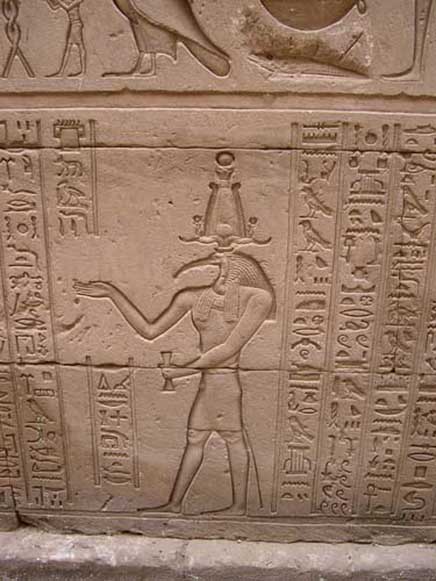
was originally the deification of the moon in the Ogdoad belief system. Initially, in that system, the moon had been seen to be the eye of Horus, the sky god, which had been semi-blinded (thus darker) in a fight against Set, the other eye being the sun. However, over time it began to be considered separately, becoming a lunar deity in its own right, and was said to have been another son of Ra. As the crescent moon strongly resembles the curved beak of the ibis, this separate deity was named Djehuty (i.e. Thoth), meaning ibis.
Thoth became associated with the Moon, due to the Ancient Egyptians observation that Baboons (sacred to Thoth) 'sang' to the moon at night.
The Moon not only provides light at night, allowing the time to still be measured without the sun, but its phases and prominence gave it a significant importance in early astrology/astronomy. The cycles of the moon also organized much of Egyptian society's civil, and religious, rituals, and events. Consequently, Thoth gradually became seen as a god of wisdom, magic, and the measurement, and regulation, of events, and of time. He was thus said to be the secretary and counselor of Ra, and with Ma'at (truth/order) stood next to Ra on the nightly voyage across the sky, Ra being a sun god.
Thoth became credited by the ancient Egyptians as the inventor of writing, and was also considered to have been the scribe of the underworld, and the moon became occasionally considered a separate entity, now that Thoth had less association with it, and more with wisdom. For this reason Thoth was universally worshipped by ancient Egyptian Scribes. Many scribes had a painting or a picture of Thoth in their "office". Likewise, one of the symbols for scribes was that of the ibis.
During the late period of Egyptian history a cult of Thoth gained prominence, due to its main center Khnum (Hermopolis Magna), also becoming the capital, and millions of dead ibis were mummified and buried in his honor. The rise of his cult also led to his cult seeking to adjust mythology to give Thoth a greater role.
Thoth was inserted in many tales as the wise counsel and persuader, and his association with learning, and measurement, led him to be connected with Seshat, the earlier deification of wisdom, who was said to be his daughter, or variably his wife. Thoth's qualities also led to him being identified by the Greeks with their closest matching god Hermes, with whom Thoth was eventually combined, as Hermes Trismegistus, also leading to the Greeks naming Thoth's cult centre as Hermopolis, meaning city of Hermes.
It is also viewed that Thoth was the God of Scribe and not a messenger. Anubis was viewed as the messenger of the gods, as he travelled in and out of the Underworld, to the presence of the gods, and to humans, as well. Some call this fusion Hermanubis. It is in more favor that Thoth was a record keeper, and not the messenger. In the Papyrus of Ani copy of the Egyptian Book of the Dead the scribe proclaims "I am thy writing palette, O Thoth, and I have brought unto thee thine ink-jar. I am not of those who work iniquity in their secret places; let not evil happen unto me." Chapter XXXb (Budge) of the Book of the Dead is by the oldest tradition said to be the work of Thoth himself.There is also an Egyptian pharaoh of the Sixteenth dynasty of Egypt named Djehuty (Thoth) after him, and who reigned for three years.
Center of Worship
During the late period of Egyptian history a cult of Thoth gained prominence, due to its main centre, Khnum (Hermopolis Magna), in Upper Egypt also becoming the capital, and millions of dead ibis were mummified and buried in his honor. The rise of his cult also lead to his cult seeking to adjust mythology to give Thoth a greater role, including varying the Ogdoad cosmogony myth so that it is Thoth who gives birth to Ra/Atum/Nefertum/Khepri, as a result of laying, as an ibis, an egg containing him. Later it was said that this was done in the form of a goose - literally as a goose laying a golden egg. The sound of his song was thought to have created four frog gods and snake goddesses of the Ogdoad who continued Thoth's song, helping the sun journey across the sky.
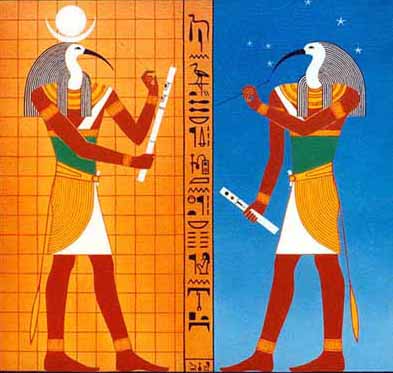
Thoth was the 'One who Made Calculations Concerning the Heavens, the Stars and the Earth', the 'Reckoner of Times and of Seasons', the one who 'Measured out the Heavens and Planned the Earth'. He was 'He who Balances', the 'God of the Equilibrium' and 'Master of the Balance'. 'The Lord of the Divine Body', 'Scribe of the Company of the Gods', the 'Voice of Ra', the 'Author of Every Work on Every Branch of Knowledge, Both Human and Divine', he who understood 'all that is hidden under the heavenly vault'. Thoth was not just a scribe and friend to the gods, but central to order - ma'at - both in Egypt and in the Duat. He was 'He who Reckons the Heavens, the Counter of the Stars and the Measurer of the Earth'.42 Books of Thoth
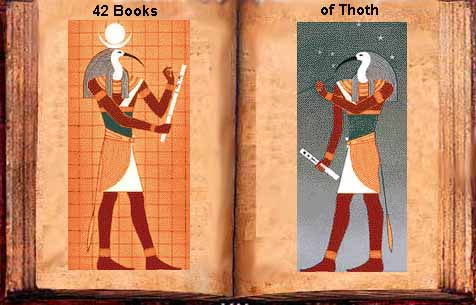
Thoth as Hermes in ancient Greece complied the Hermetic Text referred to him as Kore Kosmu. What he knew, he carved on stone mataphor of physical plane then hid most of the information. The sacred symbols of the cosmic elements he hid away using the secrets of Osiris, keeping and maintaining silence, that younger ages of the cosmic time clock might seek them out. Thoth was said to have succeeded in understanding the mysteries of the heavens and to have revealed them by inscribing them in sacred books which he then hid here on Earth, intending that they should be searched for by future generations but found by those of the bloodline.
Some of these sacred books are referred to as the 42 Books of Instructions or the 42 Books of Thoth which describe the instructions for achieving immortality plus 2 more books kept separately. The dating of the books is somewhere between the third century BC and the first century AD. Their influence has been tremendous on the development of Western occultism and magic. Neo-pagan witchcraft contains many rituals and much esoteric symbolism based upon Hermetic writings.
According to one legend Hermes Trismegistus, who was a grandson of Adam and a builder of the Egyptian pyramids, authored the books. But, more probably the books were written by several succeeding persons. According to legend, the books were initially written on papyrus.
A chronicler of pagan lore, Clement of Alexandria, stated thirty-six of the Hermetic books contained the entire Egyptian philosophy; four books on astrology; ten books called the Hieratic on law, ten books on sacred rites and observances, two on music, and the rest on writing, cosmography, geography, mathematics and measures and training of priests. Six remaining books concerned medicine and the body discussing diseases, instruments, the eyes and women. Most of the Hermetic books - along with others - were lost during the burning of the royal libraries in Alexandria. The surviving books were secretly buried in the desert where they are presently located. A few initiates of the mystery schools, ancient secret cults, allegedly know their location. What remains of the surviving Hermetic lore has been passed down through generation and published in many languages.
Most important of all are three works.
The most important and oldest is The Divine Pynander. It consists on 17 fragments all in one work. Within these fragments are many of the Hermetic concepts, including the was divine wisdom and the secrets of the universe were revealed to Hermes and the way in which Hermes established his ministry to spread this wisdom throughout the world. The Divine Pynander apparently was revised during the first centuries AD but lost none of its meaning due to incorrect translations.
Poimmandres or The Vision is the second book of The Divine Pynander and perhaps the most famous. It relates Hermes' mystical vision, cosmogony, and the secret sciences of the Egyptians as to culture and the spiritual development of the soul.
The third work - Hermes Trismegistus is the wisdom of the Hermetica - the Emerald Tablets of Thoth. It's all about alchemy, time and consciousness.
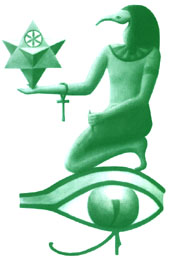
The Emerald Tablets of Thoth
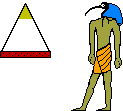
The 12 Pyramids of Thoth
Sacred Journey, Music and Meditation

The Book of Thoth
Thoth, Time, Thought, Geometry and Reality

Reality is myth, math, and metaphor. It is a consciousness computer experiment in time and illusion created by thought consciousness. The name Thoth means 'Thought' and 'Time'. Thoth was the master architect who created the blueprint of our reality based on the patterns of sacred geometry or 12 around 1.
It is here, in the duality - duat - underworld - chaos - void - place of creation 'outside the box' of our experience - reflected in gods and goddesses, the landscapes of Egypt including the pyramids and temples - that we experience until we evolve in the alchemy of time and consciousness.
Thoth's Chamber
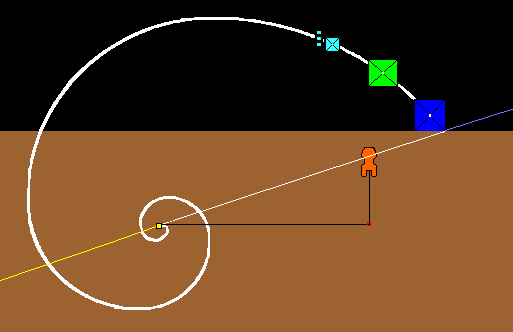
Fibonacci Sequence
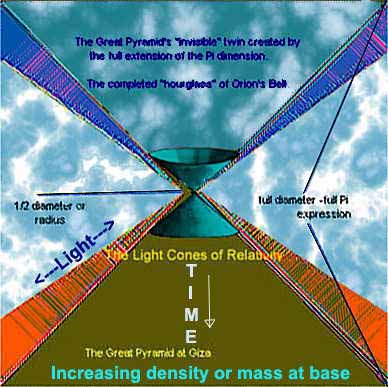 Thoth created a grid program of experience - electromagnetic in nature to allow for the bipolar aspects of linear time and illusion. Thoth constructed a pyramidal shaped vehicle which personifies the nature of reality. He placed half above - "As is Above" in the nonphysical and half below "As is Below" thus creating the sands of time - the hourglass - the X Box - at the center of the planet where it all began and will all evolve at Zero Point a time or place where all comes into balance.
Thoth created a grid program of experience - electromagnetic in nature to allow for the bipolar aspects of linear time and illusion. Thoth constructed a pyramidal shaped vehicle which personifies the nature of reality. He placed half above - "As is Above" in the nonphysical and half below "As is Below" thus creating the sands of time - the hourglass - the X Box - at the center of the planet where it all began and will all evolve at Zero Point a time or place where all comes into balance.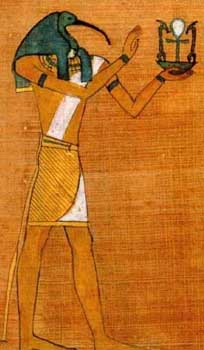 Thoth was the 'god of the equilibrium' and considered depictions of him as the 'Master of the Balance' to indicate that he was associated with the precession of the equinoxes - a time when the day and the night were balanced.
Thoth was the 'god of the equilibrium' and considered depictions of him as the 'Master of the Balance' to indicate that he was associated with the precession of the equinoxes - a time when the day and the night were balanced.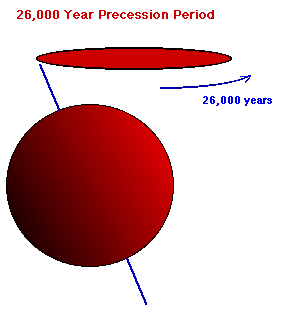
Thoth and the Pyramids In one role or another
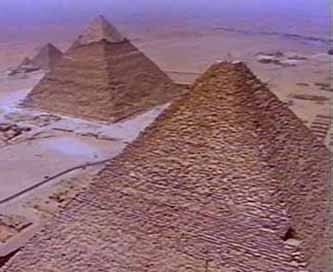
Thoth played a crucial part in the design
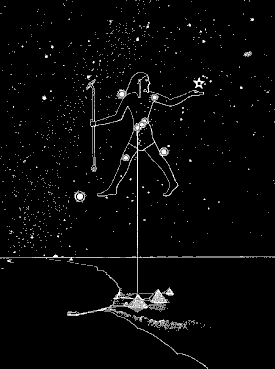
orientation and mythology
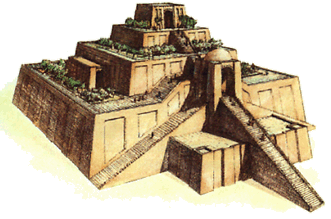
of many famous ziggurats
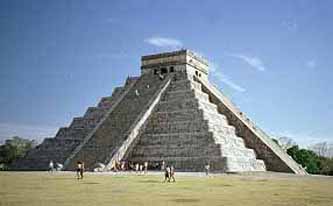 pyramids and temples.
pyramids and temples.Thoth and Hidden Knowledge
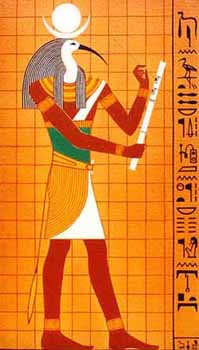 It is written in several ancient texts that Thoth wrote a
It is written in several ancient texts that Thoth wrote a 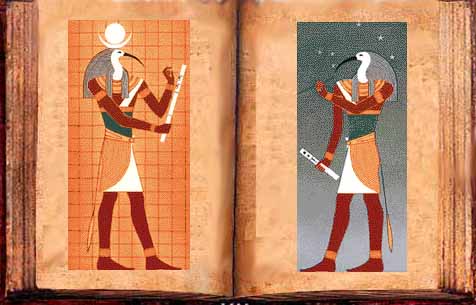
major work of scriptural importance that would one day be found.
Thoth allegedly wrote books in which he set forth
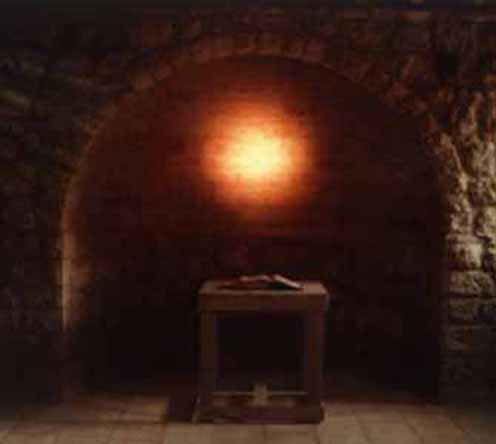
fabulous knowledge of magic and incantation then concealed them in a tomb.
Thoth in Other Famous God Roles
Sumer: Enki among other creational forces depicted in myths about reality as a biogenetic experiment with extraterrestrial connotations
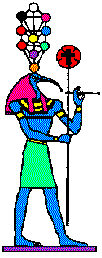 Mesoamerica: Quetzalcoatl
Mesoamerica: QuetzalcoatlInca Viracocha
Rome: Mercury The Messenger
Greece: Hermes Weights and Measures, Travel
Celtic: Merlin the Magician and Storyteller
Atlantis Chiquitet, Tehuti,Zep Tepi
Persia Zarathustra or Zoroaster - Z
The list of roles this soul played is endless from all mythological gods, religious figures, famous people in science and history, creational forces including alien gods, etc.
According to a very old Masonic tradition, the Egyptian god Thoth played a major part in preserving knowledge of the mason craft and transmitting it to mankind after the flood. Our reality is a Masonic Program - Mother Sound - Creation by Harmonics - Symbolized by the Pyramid and the Eye - the Dollar Bill and the collapse of the economy at the end of time.
The Maya clock

No comments:
Post a Comment